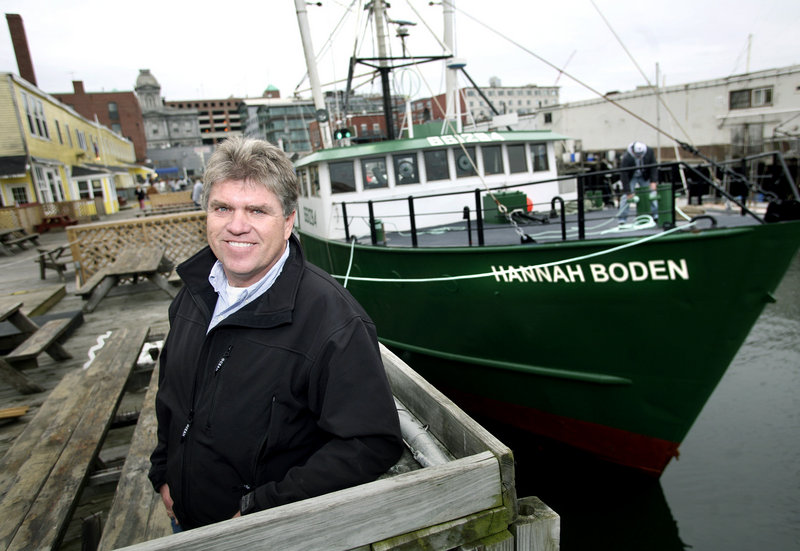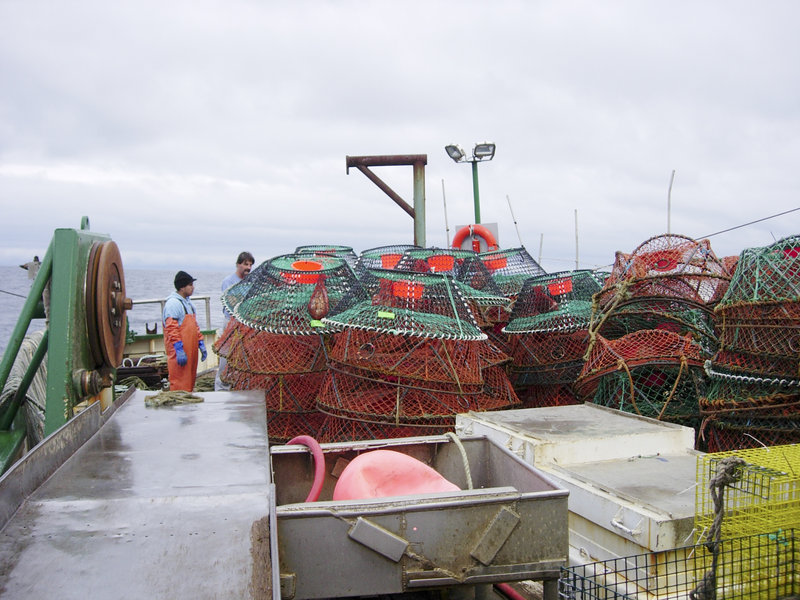Jon Williams, a Westport fisherman, is working to make the Atlantic deep-sea red crab as popular as the West Coast’s king, snow and Dungeness varieties.
Fifteen years after he started to fish for the crabs 120 miles off the East Coast, Williams is close to achieving his goal of putting the obscure crustacean on the culinary map.
“It is very little-known, but we are trying to change that,” said Williams.
While many fishermen dispute scientists’ assessments of the health of New England’s groundfish stocks and other marine species, Williams has actively sought out researchers’ help. The results have allowed him to become virtually a one-man fishery.
He owns the majority of the handful of permits allowed to catch deep-sea red crab — a fishery valued at $2.4 million to $4.2 million a year between 2004 and 2008, according to the New England Fishery Management Council. Williams owns the dominant share of the crab fishing fleet and has just opened his own deep-sea red crab processing plant.
After an eight-year effort, the Atlantic deep-sea red crab last year became the only fish species on the East Coast and the only crab fishery in the world to be certified as sustainably fished by the Marine Stewardship Council, considered the gold standard of sustainable fisheries accreditors. Williams is betting that the hard-won accreditation and the growing demand for sustainably caught seafood will make the red crab a regular at high-end seafood counters and on restaurant menus.
Williams, 52, grew up in Mechanic Falls in a family that didn’t fish. He started out captaining marine research vessels after graduating from Maine Maritime Academy. He then spent a decade fishing for king crab and snow crab in the Bering Sea, off Alaska.
He switched to the Atlantic deep-sea red crab in 1995, after spotting a help-wanted ad seeking a captain for the Hannah Boden, a swordfishing boat that was being equipped for crab fishing in the off season. The boat gained fame as the sister ship of the Andrea Gail, which sank in the 1991 so-called No-Name Storm, the subject of the book and movie “The Perfect Storm.”
When Williams started going after red crab, it was an on-again, off-again, unregulated fishery. He saw the possibilities in a niche market for the crab, which he originally sold to the Red Lobster restaurant chain as a generic crab product. Williams bought his first boat, the Hannah Boden, in 1996.
When he learned that two Alaskan factory ships with 50-man crews were headed to the East Coast intending to fish for deep-sea red crabs after their own fishery collapsed, he alerted regulators.
“I knew they were capable of totally destroying the resource,” said Williams.
Williams convinced regulators to shut down the fishery for a year, in 2000, which led to the first-ever management plan for deep-sea red crab by the New England Fishery Management Council.
The plan limits the catch to 75,000 pounds per trip and 4 million pounds a year. Only five permits are allowed, and those were awarded to those already historically in the fishery, a small group that included Williams. The rules made the fishery unattractive to the factory boats.
Since then, Williams has gained majority ownership of the five permits, at a price he declined to make public. He has put together a fleet of four boats.
He started pursuing research grants and working with scientists, such as Rick Wahle, at the University of Maine’s Darling Marine Center in South Bristol, and Shelly Tallack, at the Gulf of Maine Research Institute in Portland.
The goal was to understand the abundance of Atlantic deep-sea red crabs and the impact of harvesting on the species. Armed with that information, Williams could then apply for Marine Stewardship Council certification.
Not much is known about the creatures. Atlantic deep-sea red crabs spend their lives 2,000 feet under the sea on the edge of the continental shelf. It is difficult to study a species that lives so far below the ocean’s surface. Because it is one of the smallest regulated fisheries on the East Coast and possibly the country, it has escaped major scrutiny by regulators.
“Much of what is known is taken from other crab species in this family,” said Tallack.
The scientists have learned there is little unintentional catch of other species in the deep-sea red crab fishery, probably because very few other creatures are living so deep.
Their studies have also shown that the mortality rate in the fishery is about 5 percent, considerably less than other crab fisheries, such as the Canadian snow crab, which experiences a 60 percent mortality rate.
Tallack has just launched a study to test an onboard electronic monitoring system for recording the catch and discards during routine fishing trips.
It took Williams eight years to win sustainability certification, which was key to his marketing plan for the crustaceans. Five years was spent amassing the research, followed by three years for the rigorous certification process.
He opened his own processing plant, The Atlantic Red Crab Co., last year in New Bedford, Mass. Williams looked into opening a plant in Portland, but New Bedford is more centrally located to the fishery. He began peddling the crabmeat under his own label.
Angelo Ciocca, owner of Nova Seafoods, is a partner in the venture. Slade Gorton and Co. in Boston is the distributor.
Today his operation, which employs about 100 people, is selling the crabs both in the shell or picked at Whole Foods Market stores across the country. It is on the menu of Ruth’s Chris Steak House, a national restaurant chain based in Heathrow, Fla.
Williams said the potential for his product is there — last week, he was getting $11 a pound for picked meat — but the costs of doing business are huge. A single trip can result in a $15,000 fuel bill. There are the salaries of five to six crew members for each trip to cover.
The boats go out about 10 days at a time, fishing with 600 round, 4-foot-high traps. The crabs are hauled live into onboard tanks filled with 38-degree water. Once on shore, they are either processed immediately or held live in tanks.
The crabs are killed, and the meat is then removed and cooked and packaged. Williams is also developing a live crab business.
Barbara Gulino, marketing team leader for Whole Foods Market in Portland, where the crab was selling for $8.99 for a 6-ounce container of meat last week, said the crab is a big hit. The taste is described as delicate and sweet.
Gulino said her customers like the crab because it is local and fresh, Marine Stewardship Council-certified and caught by American fishermen.
“We have educated customers,” she said.
Staff Writer Beth Quimby can be contacted at 791-6363 or at:
bquimby@pressherald.com
Copy the Story Link
Send questions/comments to the editors.








Success. Please wait for the page to reload. If the page does not reload within 5 seconds, please refresh the page.
Enter your email and password to access comments.
Hi, to comment on stories you must . This profile is in addition to your subscription and website login.
Already have a commenting profile? .
Invalid username/password.
Please check your email to confirm and complete your registration.
Only subscribers are eligible to post comments. Please subscribe or login first for digital access. Here’s why.
Use the form below to reset your password. When you've submitted your account email, we will send an email with a reset code.